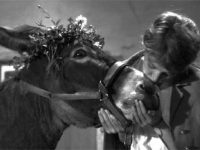French film writer and director Robert Bresson brings a very different vision to film in “A Hasard Balthazar.
According to Bresson, film should be its own art form, devoid of influence by other art forms. He makes a distinction between “movies,” which he describes as plays filmed by directors, and “cinema.” Cinema, he postulates should refrain from being influenced by theater and the acting arts.
To achieve the results he envisions, he refuses to use professional actors. To remove any latent theatrical influence that may intrude in spite of using amateur actors, he encourages his talent to memorize not lines, but syllables so that when spoken, words are devoid of inflection. Meaning must come from the images themselves and the juxtaposition of images during the editing process, not from the manner in which words are delivered for the camera.
Bresson is also interested in exploring the relationship between humankind and the divine. The central character in “A Hasard Balthazar” is a donkey. Balthazar, you may remember, was the name of one of the three Magi vising the Christ in the manger. The timeframe of this film begins with the donkey’s birth and ends with its death. At his birth, Marie, a schoolmaster’s daughter, baptizes him and lovingly tends to his needs. But fate soon separates them. The intervening years are seen through the eyes of the donkey as he is bought and sold time after time, as his owners abuse and misuse him, as he watches Marie fall in with Gerard, a young delinquent that turns her from the gentle caregiver of his youth to a wizened woman fleeing her own demons. The only relief for Balthazar is for a few years when he is owned by the town drunk who treats him kindly.
In his older years, we are told that Balthazar is a saint. If that is Bresson’s intention he seems to be asking us to reflect on how we behave in the presence of the divine – a divinity that, while calling upon us to manifest our faith in everyday life, allows us freedom to do otherwise without intervention.
Bresson calls for us to look inward, to reflect on his story deeply enough for us to bring our own emotions to the tale rather than having him guide our emotional responses. In doing so, he explores a unique role for the moving image.



Tina Siemens
Calvin King
Bob Gerber